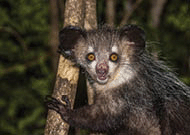Return to 2nd Quarter 2021 articles.



Scientists use animal classification systems based on old evolutionary assumptions. The result is that many times an animal does not fit any evolutionary model. An excellent example of this is a species of long-fingered, nocturnal lemurs found only in Madagascar called aye-ayes.
Aye-ayes have many unusual characteristics giving them a name that comes from a local phrase meaning something like “I don’t know.” Here are a few of the aye-aye’s traits:
- They have large round eyes, which aid in night vision.
- They use their continually growing incisor teeth to tear a hole in trees to reach grubs. Their teeth are so strong they can chew through cement blocks.
- Their long middle finger is skeletal and has a ball-and-socket joint used to hook onto wood-boring grubs.
- Their big toe is opposable to enable them to hang from tree branches.
- They have fur with guard hairs they can raise to appear to double their size.
- They use a unique system of foraging by percussive tapping on wood. They sense the echo with their bat-like ears to detect hollow areas where grubs are.
- They build elaborate spherical nests made of leaves and branches.
Because of their teeth, nesting behavior, and long tail, your first guess might be that they are rodents. Despite the face of a possum, the teeth of a mouse, and the ear of a bat, they are classified as primates. This lemur is so unusual it has its own taxonomic family.
Aye-ayes have many unusual characteristics that point out weaknesses in the evolutionary taxonomic system. From an apologetics standpoint, it seems clear that God has created a variety of animals and given them characteristics to fill various ecological niches. Aye-ayes seem to be a special creation for a unique environment.
Picture credits:
© javarman. Image from Big Stock.com.
